ayout 1 - Logo CIA Meetings - Institut canadien des actuaires
ayout 1 - Logo CIA Meetings - Institut canadien des actuaires
ayout 1 - Logo CIA Meetings - Institut canadien des actuaires
You also want an ePaper? Increase the reach of your titles
YUMPU automatically turns print PDFs into web optimized ePapers that Google loves.
8 COLLOQUE POUR L’ACTUAIRE DÉSIGNÉ (TR-9)<br />
programming language. A company will establish procedures in order to make a change, to make an update.<br />
Typically, you will have a testing environment and a production environment. And access to the production<br />
environment will be very, very, very limited. Access to the testing environment will be limited to a few people. So<br />
what will typically happen is you will, a request will come in for a change from a user and the IT people will enact<br />
that change in the system and they will put it in their test environment. They’ll run it against the test data suite,<br />
they’ll perform other things in order to make the change. And make sure that the change was implemented<br />
correctly. Then they’ll go back to the user, they’ll get sign off that the change really was implemented correctly and<br />
promote into production. It will almost universally be a different person who promotes it into production from<br />
the people doing the testing. The users will almost never have access to the production environment. So we divide<br />
it into two aspects. One is logical access. You know, only people that are supposed to have access should have<br />
access to the production environment. And then change controls, making sure things are appropriately authorized<br />
and appropriately tested before it gets promoted.<br />
One of the most frequent breakdowns that we see has to do with logical access. So you have somebody who<br />
leaves the company or leaves the department and yet they continue to have access to the production environment.<br />
In those cases it’s a breakdown of logical access. Because you haven’t controlled who has access to the program, you<br />
can’t have control over who changed it. That actually gets you entirely out of system change controls and makes<br />
it very difficult to put reliance on the system. There are some other things that we can do to supplement, to really<br />
prove that no changes occurred, but it becomes quite difficult. Quite onerous and you will spend an awful lot of<br />
time with us.<br />
Sufficient and appropriate audit evidence is making sure that our files support our opinion, and the standard<br />
that we’re working to as an experienced auditor. So that means that somebody who has five-ten years of experience<br />
auditing can come in, pick up our files and agree with us that we should have issued an unqualified opinion. Agree<br />
with us that your financial statements are right.<br />
That is a tremendous amount of documentation. The rule from the PCAOB is if it’s not documented it’s not<br />
done. We come back and we are asking for a tremendous amount of documentation. More documentation than<br />
maybe ever before and probably more documentation than last year and next year we’ll probably ask for more<br />
documentation than we did this year. We need to support for every control that the control is operating effectively<br />
and that the substantive procedures have been done and done correctly.<br />
We’ve talked up to this point about financial statements. Most people think of the income statement, the<br />
balance sheet, statement of cash flows, etc. We are actually also including all of the notes to the financial statements.<br />
So to the extent that your note relies on a system that’s different from the system that went into making the<br />
financial statements, well we have to test that system too.<br />
In particular, when we’re looking at estimates and the actuarial liabilities would be, one good example of this,<br />
we need evidence on the assumptions used, the methodology employed and the appropriateness of it. Particularly<br />
when people are looking at approximations. So if you have, you know, you choose for some reason to model a<br />
particular policy in Excel, that being an approximation, we need to make sure that we understand what assumptions<br />
and methodology is being used and why that isn’t a good approximation of true CALM.<br />
Appropriate support is also a source of a lot of discussions. Really it comes down to: is it a reliable source?<br />
A lot of you in the room will have multiple departments in your company and you’ll consider information from<br />
the investments department to be reliable. From our perspective, it’s not reliable unless it comes from a tested<br />
system. If somebody in the investments department has modified the data coming out of your investment<br />
management system and then sent it on to you. We need to be going back to the investments group to see what<br />
modification has been made or to prove that no modification has been made and tracing it all the way back to<br />
the investment system.<br />
Tested systems are good. Third party is good. Third party being an outside person with an obligation to keep<br />
the data, so a bank that’s maintaining the chequing account would be good, the bank maintaining a lock box<br />
would not be so good as to the content because they’re not responsible for maintaining the content.<br />
Vol. 19, septembre 2008<br />
DÉLIBÉRATIONS DE L’INSTITUT CANADIEN DES ACTUAIRES





